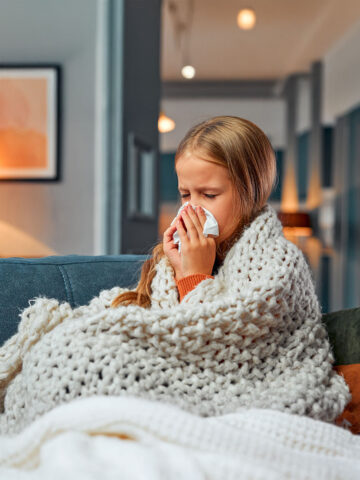What is parvovirus and should parents worry about it?
Parvovirus B19 infection is on the rise in the United States, particularly for children ages 5 to 9, which has prompted the U.S. Centers for Disease Control and Prevention to issue a health advisory.
But what is parvovirus, what conditions does it cause, and should parents worry?
Here, CHOC pediatrician Dr. Harry Pellman offers information, advice, and reassurance to parents.
What is parvovirus?
Parvovirus B19 – which causes a condition known as erythema infectiosum, fifth disease or “slapped cheek disease” – is a very common viral illness that most kids recover from quickly and without problems. Dr. Pellman says it mostly affects children ages 6 months and into the younger school ages.
This infection commonly causes bright red cheeks in a child (which is why people sometimes call it ‘slapped cheek disease’) and then a rash on the body.
“All in all, this is a very common, mild illness in almost all children, and one that many parents probably don’t even know is occurring in their child because of the few and mild symptoms that are usually present,” Dr. Pellman says.
What are the signs and symptoms of parvovirus?
Commonly, a child with parvovirus had a low fever, headache or a stuffy or runny nose prior to the typical rashes it causes. These mild symptoms dissipate and the illness seems gone, but then the rash appears shortly afterwards. Children younger than age 10 are most likely to get the rash.

What does a parvovirus rash look like?
The typical parvovirus rash typically begins on the face and turns the cheeks bright red. Then, typically, lighter red blotches will appear on a child’s upper chest, back, arms and legs and slowly spread the next few days.
“The usual story is a child comes in because of the rash on their trunk, but feels perfectly fine,” says Dr. Pellman. “When we see the child, we also notice that the cheeks are very red, almost like sunburn. The parent usually assumes the cheek redness is from sunburn.”
The torso rash– also referred to as “truncal” – is usually initially most prominent in the upper trunk and upper arms and seems to be less prominent further away from these areas, Dr. Pellman says.
The rash might be mildly itchy.
“The rash is very distinctive and has a ‘lace-like’ appearance, different from most infectious rashes that we see,” Dr. Pellman says. “It can slowly spread and may even come and go for days afterwards, especially when there is greater skin blood flow, like after having a bath or running around.”
Do all kids get a rash from parvovirus?
In older kids and adults, parvovirus might not cause the red cheek rash. In addition, it can cause joint swelling and pain afterwards that is usually transient. Rarely the joint issue can last from weeks to months. But in time, it usually goes away without any joint damage or lasting problems.
How do infected people spread parvovirus?
An infected person spreads parvovirus through droplets when they cough, sneeze, or touch surfaces.”
Dr. Pellman says the incubation period – or the time it takes to develop symptoms after exposure – is 4 to 14 days.
Fifth disease or slapped cheek disease, caused by parvovirus, is contagious before the rash appears, when the symptoms seem like that of a common cold or even when no symptoms are present. By the time the rashes appear, the person is no longer contagious.

How do doctors diagnose parvovirus?
Doctors diagnose fifth disease by seeing the typical rash on the face and body. Doctors may also do blood tests for parvovirus B19 if needed.
How do doctors treat parvovirus?
There is no medication to kill the parvovirus. If the itching causes discomfort, you can use an anti-itch medication like cetirizine. If the joint ache is uncomfortable, you can use ibuprofen. In most cases, the illness is so mild that doctors don’t need to administer treatment.
Do not give aspirin to your child, as it can lead to a rare but serious illness called Reye syndrome when given to kids with certain viral infections.
What problems can parvovirus cause?
There are a few unusual, potential problems with this usually very mild illness. The most common are the following:
First, Dr. Pellman says, the infection slows down red blood cell production temporarily. This is not a problem unless that child cannot tolerate a slowed down red blood cell production. This could be an issue in children that have hemolytic diseases such as sickle cell disease or that have illnesses that already have a slowed down blood cell production issue like many cancers, such as leukemia.
It is not unusual to have temporary joint swelling and stiffness, which might imitate a very mild arthritis, even a short time after the illness seems gone. This is temporary, and does not lead to joint damage, arthritis, or other conditions, Dr. Pellman reassures.
Very rarely a child or adult with Parvovirus B19 may get a rash called “gloves and sock syndrome,” Dr. Pellman says. In this rash variant the hand and feet are affected – hence the name – with a rash where the color of the rash is more blue or bruise like and mostly limited to the hand and feet location. This is also temporary and goes away after a few days.
Finally, infection during the first half of a pregnancy in a person who has never been infected and therefore has no immunity (and most adults have been previously infected and do have immunity) are at risk for having a miscarriage.
Can parvovirus be avoided?
It’s tough to prevent parvovirus infection. It is usually spread before any symptoms are present. There is no vaccine available. But, after having fifth disease – the condition caused by parvovirus – lifetime immunity is present.
Practicing good hand hygiene is always a good idea, not only to help prevent parvovirus, but other infections as well.
When should I call the pediatrician about parvovirus?
If you suspect a parvovirus infection that fits the above picture, it is fine to wait until the doctor’s office is open. If not, or you think the child has something more serious, call your doctor’s office.
For more health and wellness resources from the pediatric experts at CHOC, sign up for the Kids Health newsletter.
Find a CHOC Primary Care Pediatrician
From babies to teens, pediatricians from CHOC’s Primary Care Network partner with parents to offer immunizations, sick visits, sports physicals and more.





